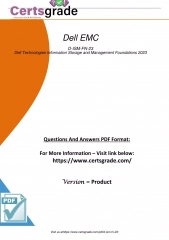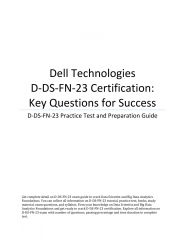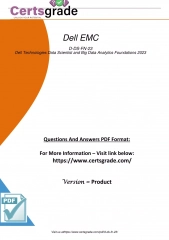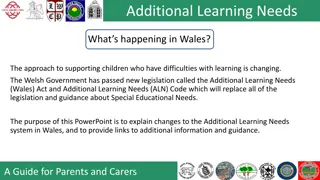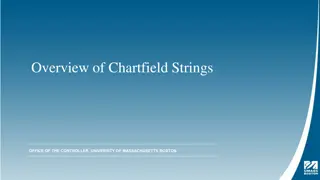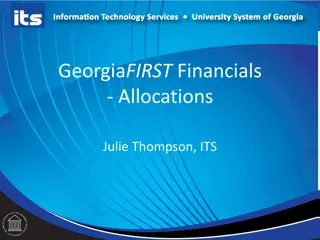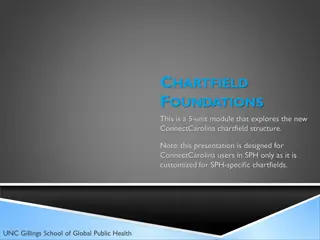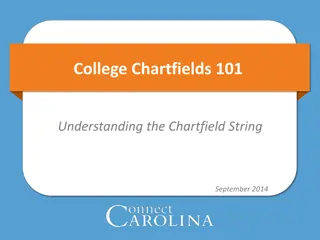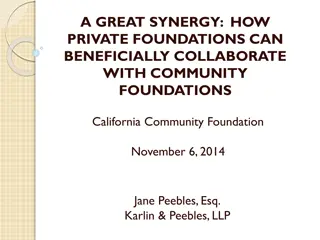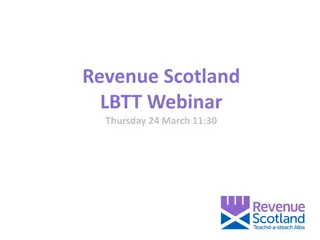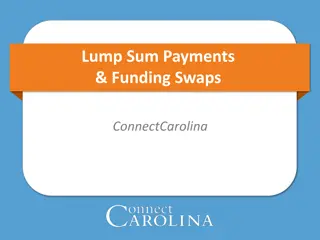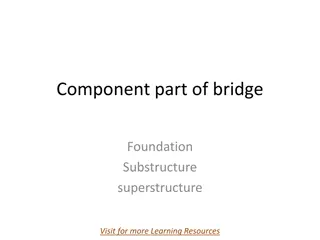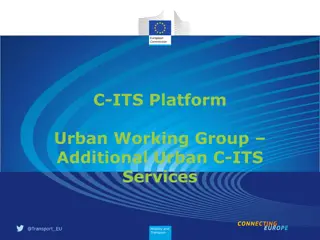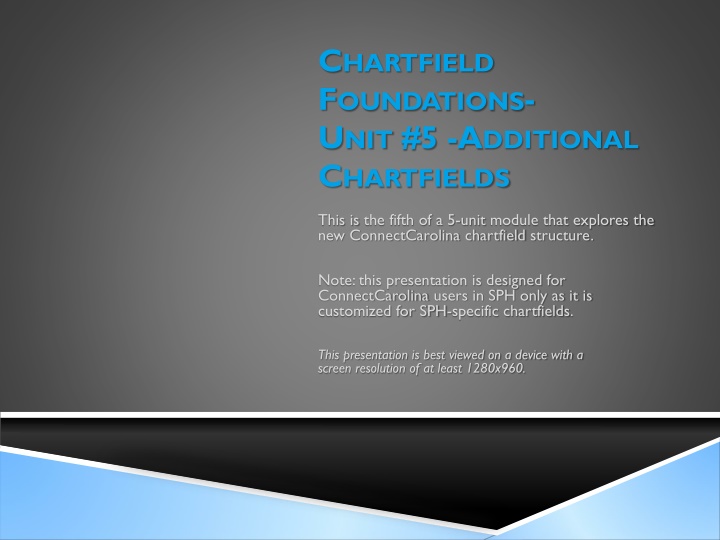
Additional ConnectCarolina Chartfields in SPH
Explore the importance of Additional Chartfields in ConnectCarolina transactions, including when they are required, the consequences of missing them, and how Optional Chartfields can be utilized. Dive into the specifics of grant and contract transactions, required Additional Chartfields, and the unique identifiers captured for each transaction line. Gain insights into the core chartfields and the key questions they answer in every transaction, ensuring compliance and accuracy in financial processes.
Download Presentation

Please find below an Image/Link to download the presentation.
The content on the website is provided AS IS for your information and personal use only. It may not be sold, licensed, or shared on other websites without obtaining consent from the author. If you encounter any issues during the download, it is possible that the publisher has removed the file from their server.
You are allowed to download the files provided on this website for personal or commercial use, subject to the condition that they are used lawfully. All files are the property of their respective owners.
The content on the website is provided AS IS for your information and personal use only. It may not be sold, licensed, or shared on other websites without obtaining consent from the author.
E N D
Presentation Transcript
CHARTFIELD FOUNDATIONS- UNIT #5 -ADDITIONAL CHARTFIELDS This is the fifth of a 5-unit module that explores the new ConnectCarolina chartfield structure. Note: this presentation is designed for ConnectCarolina users in SPH only as it is customized for SPH-specific chartfields. This presentation is best viewed on a device with a screen resolution of at least 1280x960.
#5. ADDITIONAL CHARTFIELDS After completing this unit, learners will: Understand when the Additional Chartfields are required on a transaction and what information is captured. Understand that missing Additional Chartfields will result in an error. Understand how Optional Chartfields might be used.
CORE CHARTFIELDS-RECAP We have covered the five core chartfields over the past 4 units: Business Unit Department Fund Source Account These Core Chartfields are required on each and every transaction and answer many questions about each transaction: Business Unit: Which legal entity is spending the money? UNCCH for all departmental transactions. Department: Which department is spending the money? Fund: Which major fund group is being used and for what purpose? Source: What specific source of funding is being used? Account: What is the accounting classification of items in the transaction?
ADDITIONALAND OPTIONAL CHARTFIELDS For certain transactions pertaining to grants and contracts, three Additional Chartfields are required. Project ID Activity PC Bus Unit Finally, four Optional Chartfields may be used on any transaction. Cost Code 1 Cost Code 2 Program Cost Code 3 We will go over both of these groups of chartfields. 4
ADDITIONAL CHARTFIELDS Below are three Additional Chartfields required for each transaction line involving a grant or contract. Source for grants and contracts ranges from 49000 to 49999 and represents the type of funding agency giving the grant. Unlike other types of funding, the Source for grants and contract don t act as a unique identifier. Unique grant or contract information is instead captured in the Additional Chartfields. Project ID Activity PC Bus Unit 5
ADDITIONAL CHARTFIELDS For every transaction involving a grant, Additional Chartfields are required as follows: The PC Business Unit will be CHOSR for each grant- related transaction. This chartfield indicates the transaction falls into the activities of the Office of Sponsored Research (OSR). PC Bus Unit Searching for the appropriate PC Business Unit is easy. The results list only has two items: CHCIP (capital improvement projects) CHOSR. In all cases, select CHOSR. 6
ADDITIONAL CHARTFIELDS For every transaction involving a grant, Additional Chartfields are required as follows: Project ID is the unique grant identifier. It is a 7-digit code that begins with a 5. The Project IDs will look familiar to the old grant accounts in FRS. For example: Project ID Old FRS Grant 5-32267 New Project ID 5032267 Old FRS Grant 5-46890 New Project ID 5046890 All old FRS grants will retain their similar number. New grant numbers will then be assigned incrementally. 7
ADDITIONAL CHARTFIELDS For every transaction line involving a grant, the Additional Chartfields are required as follows: Activity is the last required additional chartfield when working with contracts and grants. In all cases, the Activity will be the number 1. Even if you forget what this chartfield should be, the lookup will only have one result: 1. Activity 8
ADDITIONAL CHARTFIELDS Since the Core Chartfields are required on all transactions, and Additional Chartfields are required for all grant transactions, all grant- related transactions will have 8 chartfields. For example: Business Unit Department Fund Source Account UNCCH 460502 25210 49000 511120 Project ID Activity PC Bus Unit 5030566 1 CHOSR This chartfield string indicates the transaction was made within the university by CEHS using grant funds for organized research from a Federal agency, the CEHS Administrative Core, to pay for EPA Non-Teach salaries. 9
ADDITIONAL CHARTFIELDS Here is another example: Business Unit Department Fund Source Account UNCCH 464001 25210 49100 511170 Project ID Activity PC Bus Unit 5044806 1 CHOSR This chartfield string indicates the transaction was made within the university by Health Behavior using grant funds for organized research from an Educational & Research Institution, Tobacco Control in a Rapidly Changing Media Environment, to pay for Student monthly salaries. 10
ADDITIONAL CHARTFIELDS All existing grants will be listed in the Departmental Quick Reference Card. When the system detects a fund beginning with 252XX, which indicates that the transaction involves a contract or grant, it will be waiting for the information in the Additional Chartfields. If you enter a Fund of 252XX but neglect to enter the Additional Chartfields, you will run into a combo-edit error which will need to be fixed before you can move on. Business Unit Department Fund Source Account 252XX Project ID Activity PC Bus Unit 11
OPTIONAL CHARTFIELDS There are four Optional Chartfields. These may be used on any transaction but they are truly optional and may be skipped if appropriate. The Optional Chartfields are available to assist schools and departments to capture financial information in the way it is useful. Cost Code 1 Cost Code 2 Program Cost Code 3 12
OPTIONAL CHARTFIELDS The Optional Chartfields are available to assist schools to capture financial information in the way it is useful: The Program chartfield is used by certain areas such as the College of Arts & Sciences, School of Medicine and in some cases, the Provost s Office to capture programmatic information. SPH has decided not to roll out this chartfield at this time. In almost all instances, you can leave this blank. Since the Program is optional, however, it will always be available for entry be careful not to accidentally populate it or you may run into errors. The Program will only be required in rare cases that involve funding from the Provost and should that occur, you will be provided with the code. Program 13
OPTIONAL CHARTFIELDS The Optional Chartfields are available to assist departments to capture financial information in the way it is useful to each department: The 3 Cost Code chartfields are all similar in nature. These enable you to track costs across funding types and by categories that run across accounts. Cost Code 1 Cost Code 2 For example, you may want to track the total cost of a conference which may involve spending from both F&A and a university trust in various accounts. Cost Code 3 By coding all event-related transactions to a cost code you will be able to easily report on the aggregate costs for that event. This functionality is similar to how Infoporte may be used today. 14
OPTIONAL CHARTFIELDS The Optional Chartfields are available to assist departments to capture financial information in the way it is useful to each department: Cost codes cannot be created in an ad hoc manner. All cost codes must be uploaded into the system before they can be used. Cost Code 1 Cost Code 2 Cost codes are also set up in a specific cost code field. A cost code that is set up in Cost Code 1 will not be found in the Cost Code 2 or Cost Code 3 lists. Cost Code 3 Each department uses Cost Codes differently. Please talk to your business manager to understand how your department has chosen to use them. 15
OPTIONAL CHARTFIELDS The Optional Chartfields are available to assist departments to capture financial information in the way it is useful to each department: All SPH Cost Codes begin with H . Cost Code 1 The second digit of the Cost Code will represent your department. If you know this digit, you will be able to search for the cost codes. Cost Code 2 Cost Code 3 In this example, the search was for all cost codes that begin with H8 . 16
CHARTFIELD FOUNDATIONS Congratulations! You ve completed the final unit of Chartfield Foundations. The new chartfields will require time to digest. Don t worry about memorizing codes. Resources will be provided to facilitate your work. Please continue the presentation to take the summary test. Your answers will be kept anonymous and only reviewed in aggregate to see which areas may need additional training. Business Unit Department Fund Source Account

